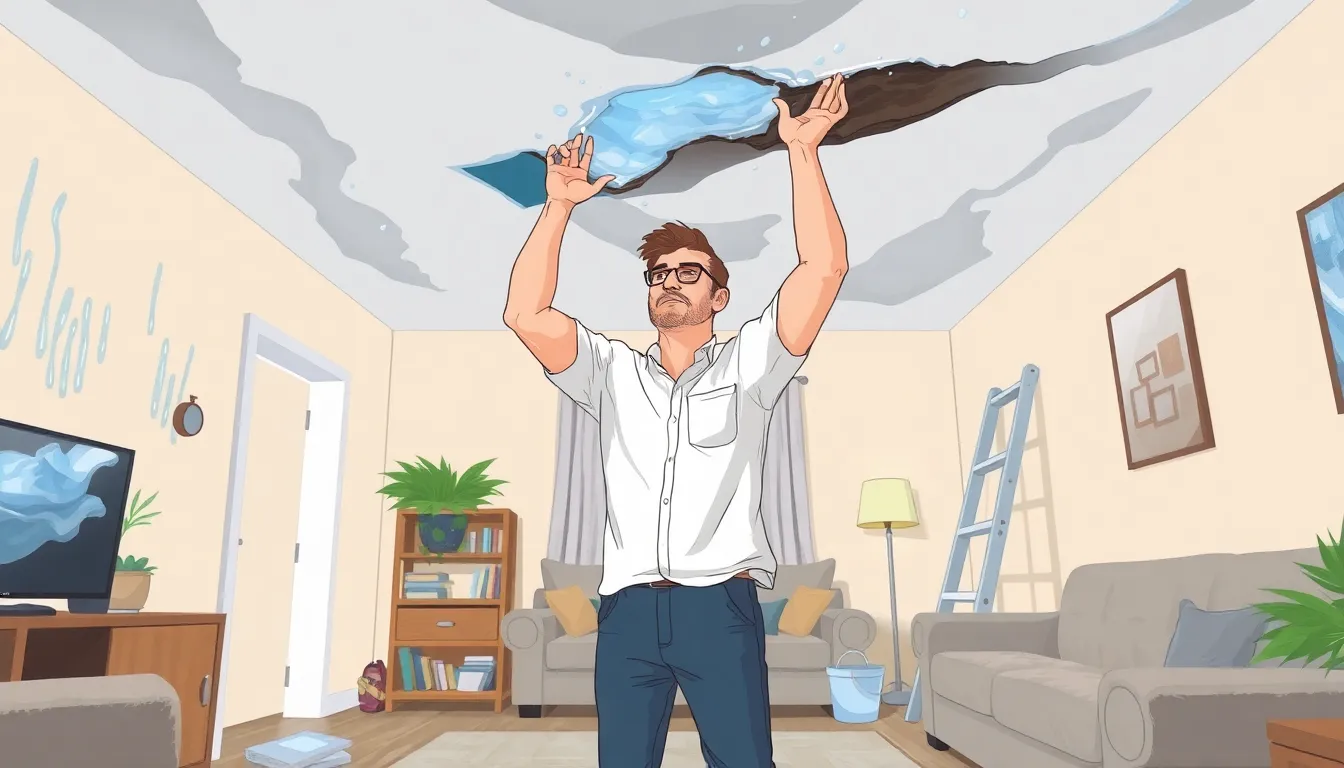Water leaks can turn a cozy home into a soggy nightmare faster than you can say “insurance claim.” Whether it’s a sneaky drip from a leaky faucet or a full-blown indoor waterfall thanks to a burst pipe, homeowners often wonder if their insurance will come to the rescue. After all, who wouldn’t want a little financial help when their home starts resembling a scene from a disaster movie?
But does home insurance really cover those pesky water leaks? The answer might surprise you. While some policies offer a safety net, others might leave homeowners high and dry. In this article, we’ll dive into the murky waters of home insurance coverage and help you navigate the ins and outs of what’s included, what’s excluded, and how to keep your home—and your wallet—safe from unexpected floods.
Table of Contents
ToggleOverview of Home Insurance
Home insurance serves as a critical financial safety net for homeowners. Generally, these policies provide coverage for various risks, including fire, theft, and certain types of water damage. Understanding policy specifics becomes essential; not all plans are the same.
Most standard homeowners policies cover sudden and accidental water leaks. This coverage typically includes incidents such as burst pipes and overflow from appliances. However, damage from long-term leaks may not be included.
Homeowners must pay attention to water-related exclusions within their policies. For instance, flood damage commonly falls outside standard home insurance coverage, necessitating separate flood insurance in high-risk areas. Some policies might also exclude coverage for neglected maintenance issues or gradual leaks resulting from lack of repair.
Selective endorsements may enhance coverage options if needed. Homeowners often customize their policies to address specific concerns, including water damage caused by sewer backups.
Understanding these nuances helps homeowners make informed decisions. Knowing the limits of their policy coverage empowers them to take appropriate measures. Engaging with an insurance agent provides clarity regarding available options and potential gaps in coverage.
Consider reviewing policy documents regularly. Changes in home value, local laws, or risk factors can impact coverage needs. By staying proactive, homeowners can ensure they adequately protect their investments against unexpected water-related events.
Types of Water Damage Covered

Understanding the different types of water damage coverage is crucial for homeowners. Policies vary widely in terms of what they protect against when it comes to water issues.
Sudden and Accidental Leaks
Most standard home insurance policies cover sudden and accidental leaks. For example, a burst pipe or an overflow from a washing machine typically qualifies for coverage. This protection includes immediate damage caused by these events, such as water stains on ceilings or walls. Homeowners must document the damage and report incidents promptly to ensure their claims are processed efficiently. In many cases, coverage also extends to repair costs and replacing damaged belongings.
Long-Term Damage and Gradual Leaks
Long-term damage from gradual leaks often falls outside standard coverage. For instance, water damage from an unnoticed drip from a faucet generally isn’t covered due to the expectation of routine maintenance. Insurance providers see this type of damage as preventable. Mold growth and deterioration that develop over time usually result in exclusions within policies. Homeowners facing these issues typically need additional specialized coverage to address potential threats to their property. Understanding these distinctions helps avoid costly surprises later.
Exclusions in Home Insurance Policies
Home insurance policies often contain specific exclusions related to water damage. Understanding these exclusions helps homeowners navigate their coverage effectively.
Common Exclusions for Water Damage
Certain types of water damage typically aren’t covered by standard home insurance policies. Gradual leaks, which occur over time, usually fall outside policy provisions. Damage from neglected maintenance often results in denials during claims. Homeowners face challenges with exclusions related to flooding as well. Separate flood insurance is necessary to cover this risk. It’s essential to read the fine print and comprehend what is and isn’t included in the policy to avoid unexpected costs.
Understanding Mold and Mildew Coverage
Mold and mildew damage present additional complexities under home insurance. Many policies exclude damage caused by these conditions. Mold usually arises from untreated water leaks or high humidity levels, leading insurers to deny claims. Some homeowners secure specific endorsements for mold coverage, but these endorsements often come with limitations. Homeowners need to maintain proper ventilation and conduct routine inspections to mitigate mold risk. Engaging an insurance agent ensures clarity regarding mold coverage specifics in the policy.
How to File a Claim for Water Damage
Filing a claim for water damage can feel overwhelming, but with the right steps, it becomes manageable. He or she should act promptly to secure coverage for the damage.
Steps to Take After a Leak
Immediately address any urgent issues by turning off the water supply. Next, assess the extent of the damage and move belongings away from affected areas. Document visible damage through photographs, capturing details of the leak source and destroyed property. Inform the insurance provider about the situation. Timely communication helps expedite the claims process. Seek professional help for necessary repairs, keeping any invoices or receipts for later submission.
Documentation for Your Claim
Accurate documentation is essential for a successful claim. Begin by collecting photographs of the damage, focusing on different angles and impacted items. Compile repair estimates from professionals, as they help validate the claim. Homeowners should maintain a record of all communications with the insurance company, including names and dates, to track progress. Include a list of damaged items, specifying their value and condition. This thorough documentation plays a critical role in ensuring a smooth claims process and maximizing reimbursement.
Understanding home insurance coverage for water leaks is essential for every homeowner. While many policies cover sudden and accidental leaks, exclusions for gradual damage and flooding can lead to unexpected costs. By staying informed about their coverage limits and engaging with insurance agents, homeowners can make educated decisions to protect their properties. Regular maintenance and prompt reporting of any incidents can further aid in the claims process, ensuring that they receive the necessary support when faced with water-related issues. Prioritizing clarity on these aspects can help safeguard both homes and finances effectively.


